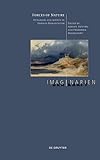Forces of Nature : Dynamism and Agency in German Romanticism / ed. by Adrian Renner, Frederike Middelhoff.
Material type: TextSeries: Imaginarien der Kraft ; 4Publisher: Berlin ; Boston : De Gruyter, [2022]Copyright date: ©2022Description: 1 online resource (256 p.)Content type:
TextSeries: Imaginarien der Kraft ; 4Publisher: Berlin ; Boston : De Gruyter, [2022]Copyright date: ©2022Description: 1 online resource (256 p.)Content type: - 9783110783773
- 9783110783827
- online - DeGruyter
- Issued also in print.
| Item type | Current library | Call number | URL | Status | Notes | Barcode | |
|---|---|---|---|---|---|---|---|
 eBook
eBook
|
Biblioteca "Angelicum" Pont. Univ. S.Tommaso d'Aquino Nuvola online | online - DeGruyter (Browse shelf(Opens below)) | Online access | Not for loan (Accesso limitato) | Accesso per gli utenti autorizzati / Access for authorized users | (dgr)9783110783827 |
Frontmatter -- Content -- Acknowledgements -- Dynamism, Agency, Interaction—An Introduction to Forces of Nature in German Romantic Literature and Sciences -- Patterns, Practices, Ethics -- “Bewegung[s]Veränderungskunst”. Mechanics and the Force of Rhythm ca. 1800 (Klopstock, Sulzer, A.W. Schlegel, Novalis) -- The Moral Force of Art. Karl Philipp Moritz on Formative Imitation and Bildung -- Practices of Translation, or: How Literature Became the Vital Force of Life -- Imagination, Sensation, Mediation -- Dynamic Perceptions. Forces of Nature and Powers of the Senses in Schelling, Novalis and Günderrode -- Daimonic Energies in Hölderlin’s Tod des Empedokles -- “Fire Machines”. Heinrich von Ofterdingen and the Transformation of Forces -- Bodies, Powers, Conflicts -- Thirsting for Blood. Romanticizing vis medicatrix naturae in Romantic Medicine and E.T.A. Hoffmann’s Ignaz Denner -- Nature’s Say. Negotiating the Human-Nature-Continuum in Ludwig Tieck’s Der Runenberg -- Homeopathy’s Dynamic Forces -- List of Contributors -- Index
restricted access online access with authorization star
http://purl.org/coar/access_right/c_16ec
By the end of the 18th century, notions of "forces of nature" (Naturkräfte) were increasingly discussed across disciplinary bounds: attraction and repulsion, vital forces and electric fluids, formative drives and biological organisms were examined as forces linked to ‘natural’ processes. German Romantic literature, science, and philosophy – from Schelling and Novalis to Günderrode and Hölderlin – pondered interrelated notions of forces considered as dynamic and continually active in nature – forces which, in turn, also appeared to shape human actions, social structures, and cultural developments. This volume explores the points of reference for, approaches to, and afterlives of Romantic conceptions and representations of natural forces at the intersection of natural sciences and cultural imaginaries.
Um 1800 diskutierte man über Naturkräfte in verschiedenen wissenschaftlichen und künstlerischen Zusammenhängen: Anziehung und Abstoßung, Lebenskräfte und elektrische Ströme, der "Bildungstrieb" und biologische Organismen wurden als Kräfte untersucht, die sich auf „natürliche" Prozesse zurückführen lassen. Literatur, Wissenschaft und Philosophie der deutschsprachigen Romantik von Schelling bis zu Günderrode und Hölderlin arbeiteten sich an Konzepten von Kräften ab, die als dynamisch und in beständiger Tätigkeit begriffen wurden – Kräfte, die auch menschliche Handlungen, soziale Strukturen und kulturelle Entwicklungen einzuschließen schienen. Der Band erkundet Vor- und Darstellungen von Naturkräften in der Romantik an der Schnittstelle von Naturwissenschaft und kulturellen Vorstellungswelten.
Issued also in print.
Mode of access: Internet via World Wide Web.
In English.
Description based on online resource; title from PDF title page (publisher's Web site, viewed 29. Mai 2023)


